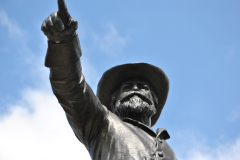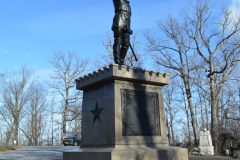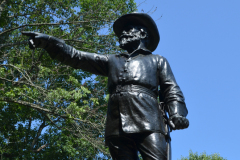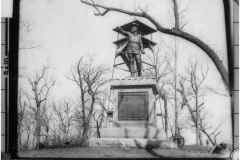Dedicated: Sept. 26-27, 1907.
Location: Culp’s Hill summit.
Description: A standing portrait of General Greene depicted pointing his troops toward battle with his raised proper right arm. The sculpture rests atop a square base adorned with a bronze New York state seal on the right side and a 12th Corps Star on the left side. The sculpture was authorized by the State of New York on May 13, 1903. The amount of $8,000 was appropriated for the monument, but only $6,863.32 was spent and the remainder was returned to the state treasury. The base was designed by A. J. Zabriskie and was constructed by Booth Brothers and Hurricane Isle Granite Company of New York. The bronze inscription plaques, New York state seal, and corps star were cast by John Williams, Inc.
National Park Service List of Classified Monuments Number: MN317.
Sculptor: Perry, Roland Hinton, 1870-1941, sculptor.
About Brevet Major General George Sears Greene

Commanded the Third Brigade of the Second Division of the Twelfth Corps.
Born May 6, 1801 in Apponaug, Rhode Island; USMA 1823. Cousin of Revolutionary War General Nathanael Greene. Professor of mathematics and civil engineering at West Point where his pupils included Robert E. Lee. He as one of the oldest field commanders in the Federal army during the Civil War. Nicknamed Pap. Came up with the 60th New York Infantry. His defense of the summit of Culp’s Hill earned him lasting fame. He was shot in the face at the Battle of Wauhatchie and finished the War with the capture of Raleigh, North Carolina. His sons were also officers; Charles served as a lieutenant on his staff at Culp’s Hill and lost a leg due to damage from an artillery shell in late 18634, while Samuel served as an officer on the USS Monitor. Greene was a distinguished civil engineer after the Civil War. He died on January 28, 1899 at the age of ninety-seven. He is buried beneath a two-ton boulder from Culp’s Hill in the family cemetery in Rhode Island.
Lt. George K. Collins of the 149th New York wrote of Greene, “He knew how to drill, how to command, and in the hour of peril how to care for his command, and the men respected him accordingly.”











